Stanbridge Manors
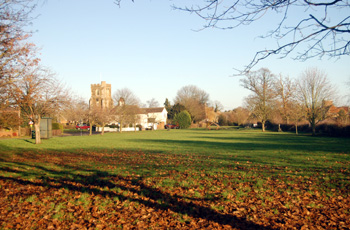
Stanbridge Green December 2008
Introduction
Considering that, until 1866, Stanbridge was a hamlet of Leighton Buzzard, it is surprising to note that it contained no less than four manors. It is even more surprising given that at the time of the Domesday Book in 1086 Stanbridge had no separate landholding but formed part of the Royal Manor of Leighton.
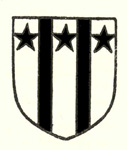
Coat of arms of the Gatesden family
Stanbridge Manor
Stanbridge Manor seems to have been carved out of the Manor of Leighton and created by King Henry I (1099-1135) for his wife Matilda. It was originally leased, at the rent of taking care of two of the King's falcons and paying £4 per annum to Newnham Priory in Bedford. The former part of the rent was altered in 1258 to an annual payment of £3 to the Exchequer, to be paid to the Chief Falconer. By 1439 it had changed again to a hundredth of a knight's fee (i.e. the cost of supporting a knight with his armour, weapons, horse etc). The payment to Newnham Priory continued to be made until the house was dissolved by King Henry VIII in 1535.
The manor is mentioned in the Pipe Roll of 1166, when the Sheriff of Bedfordshire, administering it on behalf of the Crown, restocked it with sixteen oxen (32 shillings), two affers (six shillings), four cows (twelve shillings), four young beasts (four shillings), two hundred sheep (five marks), six swine (six shillings) and six young pigs (four shillings).
In the late 12th century the manor was held by Audufus de Gatesden and his descendents held it until the late 13th century when it passed, by marriage, on the death of John de Gatesden, to the Chamberlain family. On Gatesden's death the manor is described thus in the Calendar of Inquisitions Post Mortem [not held at Bedfordshire & Luton Archives & Records Service]: "A messuage with garden, herbage, fishpond and dovecot, 170 acres arable, 8 acres meadow, pasture, 118 shillings 1½ pence rents of free tenants, 1 pound of pepper, 1 pound of cumin…and two parts of a windmill, held of the King in chief by serjeantry, rendering 60 shillings yearly at the King's exchequer…".
The Chemberlain family held the manor until the 16th century, as they did Tilsworth Manor, which they acquired in 1373. The Chamberlains were succeeded as holders of the manor by the Fowler family. John Fowler sold the manor in 1601 to John Iremonger who died in 1613. The Iremongers held the manor until sold in 1678 to Ralph Baldwin. Lack of surviving evidence makes the following history of the manor difficult to determine but it was said to have descended by inheritance to a Rev.John Pitman about 1767; certainly he sold it in 1781 to Thomas Gurney. The Hanmer family, Lords of the Manor of Leighton alias Grovebury and other manors later acquired the manor. In the early 1920s a succession of laws of property acts abolished copyhold tenure leaving the Lord of the Manor nothing but an empty title.
The manor house seems to have stood just north of the lower school. It stood in Great and Little Bury Closes, the site marked by a large number of earthworks before these were levelled to create the school playing field in 1961.
The exact histories of the other three manors (or, more correctly, sub-manors, since they were held of Stanbridge Manor), are difficult to determine. This is through a current lack of documentary evidence.
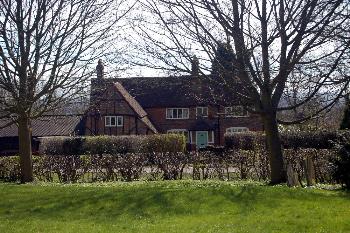
Green Farmhouse March 2008
Kimptons Manor
Kimptons Manor was held from Stanbridge Manor at an annual rent of six shillings and four pence. It may have originated in land held by the Kimpton family who were in Billington as early as 1393. By 1496 it was held by the Billington family, Lords of Billington Manor who, in that year, leased it to Joan, wife of Edmund Haslewood, and married to the Billington heir, John.
The Calendar of Close Rolls [not held by Bedfordshire & Luton Archives & Records Service] describes this manor in 1470 as: "…a messuage, four enclosures with ditches and 95 acres of land, 5 acres of meadow, 9 shillings 3 pence of rent…in the fields of Stanbridge, Eggington, Billington and Tilsworth, in the County of Bedford…".
Evidence for the manor's descent is quite sparse, the next mention being of a Robert Dormer alienating the manor to William Jackman of Wing [Buckinghamshire] in 1539, In 1556 John Jackman sold the manor to Robert Brocas. William Brocas alienated the manor to Henry Honnor in 1579.
The Honnor family held the manor until 1719 when it was sold to Thomas Cowslade. It was held by John Cowslade in 1774 but is next mentioned in 1822 as being in the possession of Richard Thomas Gilpin. The manor seems to have been based around Green Farm.
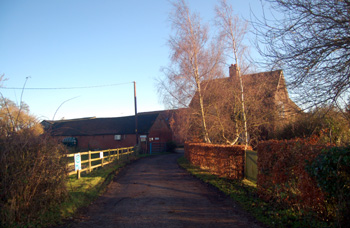
Bluegate Farm December 2008
Morrells Manor
The first mention of this manor, which, like Kimptons, was held of Stanbridge Manor, is in 1446 when it was in the possession of John Morrell. His daughter married into the Brocas family and the manor stayed with this family until sold to William Bawdery in 1577. Thomas Ellingham bought the manor in the last years of the 16th century. Daniel Ellingham, who has a memorial in Stanbridge church, may have been a descendent of his. Another descendant, also Thomas, became bankrupt and was forced to sell the manor to John Capon in 1744. Half the manor was sold to John Franklin in 1747. Eventually both halves were united in another John Franklin in 1797 and 1799 respectively. After this the manor receives no further mention. The manor seems to have been based around Bluegate Farm.
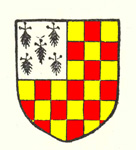
Coat of arms of the Reynes family
Morteynes alias Reynes Manor
This sub-manor, also held from the Manor of Stanbridge is first mentioned in the 16th century. The Reynes family held land in Stanbridge in 1471 and the female heir of the family married a Decons, who was Lord of the Manor in 1511. Thomas Decons alienated it to Richard Bury and William Duncombe in 1544 and William Draper alias Rawlyns bought it from them in 1562. His son Gabriel possessed the manor in 1604 but at some point, documentary evidence is lacking, it passed to the Wigg family who sold it to Alice Brandreth in 1700. On the death of Henry Brandreth around the middle of the 18th century the manor passed to his sister Anne, wife of William Duncombe. Her son Brandreth Duncombe sold the manor to John Franklin, the Lord of the Manor of Morrells, in 1786 and presumably the two manors were henceforward held together. The manor seems to have been based around Ivy Farm.